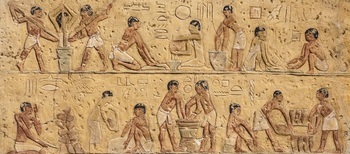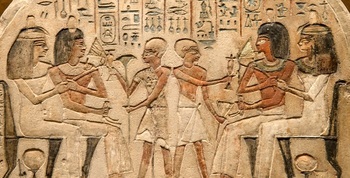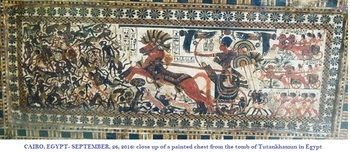

The ancient Egyptians are famous for their monumental architecture, advanced writing system, and intricate religious beliefs.  However, they were also skilled warriors who engaged in frequent conflicts with neighbouring powers. Ancient Egyptian warfare was a complex and multifaceted affair that evolved over time as the Egyptians developed new weapons, tactics, and military structures.
However, they were also skilled warriors who engaged in frequent conflicts with neighbouring powers. Ancient Egyptian warfare was a complex and multifaceted affair that evolved over time as the Egyptians developed new weapons, tactics, and military structures.
Warfare in ancient Egypt was common, as the country was surrounded by hostile neighbors and faced constant threats from foreign powers. The Egyptians engaged in a variety of military campaigns, from small-scale skirmishes to full-scale invasions. However, unlike many ancient civilizations, the Egyptians did not have a standing army or a professional military class. Instead, they relied on a system of conscription, where able-bodied men were drafted into military service for a period of one to three years. This meant that the Egyptian army was composed of a diverse range of soldiers, from peasant farmers to nobles and even members of the royal family.
The Egyptians engaged in a variety of military campaigns, from small-scale skirmishes to full-scale invasions. However, unlike many ancient civilizations, the Egyptians did not have a standing army or a professional military class. Instead, they relied on a system of conscription, where able-bodied men were drafted into military service for a period of one to three years. This meant that the Egyptian army was composed of a diverse range of soldiers, from peasant farmers to nobles and even members of the royal family.
The first evidence of professional soldiers in ancient Egypt dates back to the Middle Kingdom period (2055-1650 BCE), when the Egyptian army began to adopt a more centralized and professional structure. During this period, the pharaohs established a standing army composed of full-time soldiers, who were paid and trained to fight year-round. These professional soldiers were organized into units based on their skill level and equipment, and they were led by experienced officers who were responsible for their training and discipline.
One of the key advantages of a professional army was that it allowed for greater consistency in military strategy and tactics.  Professional soldiers were trained in standardized techniques and were led by experienced officers who were responsible for their training and discipline. This meant that the Egyptian army was able to develop a more sophisticated and effective approach to warfare, as soldiers were able to work together more effectively and respond more quickly to changing battlefield conditions.
Professional soldiers were trained in standardized techniques and were led by experienced officers who were responsible for their training and discipline. This meant that the Egyptian army was able to develop a more sophisticated and effective approach to warfare, as soldiers were able to work together more effectively and respond more quickly to changing battlefield conditions.
Another advantage of professional soldiers was that they had access to better equipment and weapons. While conscripted soldiers in earlier periods were often poorly equipped, professional soldiers were provided with the best available equipment, such as bronze swords, spears, and shields. They also had access to more advanced weapons, such as the composite bow, which was made of layers of wood, bone, and sinew and had a much greater range and accuracy than the simple bows used by most soldiers.
The Egyptian army during the Old Kingdom was composed mainly of conscripted soldiers who were called upon to fight in times of war. These soldiers were typically drawn from the general population and lacked the specialized training and equipment of professional soldiers. However, despite their lack of training, they were still highly effective in battle.
The Old Kingdom army was divided into two main types of soldiers: infantry and charioteers. Infantry soldiers were the backbone of the Egyptian army and were armed with a variety of weapons, including spears, clubs, axes, and short swords. They were organized into units based on their place of origin, with each unit being led by a local commander.
One of the most important weapons of the Old Kingdom period was the mace. The mace was a heavy weapon made of stone or metal and was used by infantry soldiers to strike their opponents with powerful blows. Another important weapon was the khopesh, a curved sword that was used for close combat. The khopesh was a highly effective weapon, as its curved shape allowed it to hook onto an enemy's shield and pull it away, leaving them vulnerable to attack.
In the Middle Kingdom period, the Egyptians developed new weapons and tactics that allowed them to conquer neighboring territories and establish a powerful empire. The introduction of the chariot, for example, revolutionized warfare in ancient Egypt, as it allowed soldiers to move quickly across the battlefield and strike at their enemies from a distance. The Middle Kingdom also saw the development of new types of armor, such as the bronze cuirass, which provided better protection for soldiers than the leather or linen armor used in earlier periods.
In conclusion, ancient Egyptian warfare was a complex and multifaceted affair that evolved over centuries. From the simple skirmishes of the Old Kingdom to the professional armies of the Middle Kingdom, the Egyptians developed a variety of weapons and tactics to achieve victory in battle. While the Egyptians did not have a standing army or a professional military class in the early stages of their history, they eventually developed a centralized and professional military structure that allowed them to conquer neighboring territories and establish a powerful empire.
Q1. How did ancient Egyptian warfare influence their art and culture?
Ans. Ancient Egyptian warfare had a significant influence on their art and culture, as military themes and motifs were prominently featured in their art and literature. For example, many pharaohs commissioned statues and reliefs that depicted them as victorious warriors, and military accomplishments were often celebrated in temple inscriptions and hymns.
Q2. How did ancient Egyptian armies communicate during battle?
Ans. Ancient Egyptian armies communicated during battle using a system of horns, drums, and signal flags. Each unit had its own set of signals, which allowed commanders to coordinate their movements and issue orders to their soldiers.
Q3. Did the ancient Egyptians use war elephants?
Ans. While war elephants were used in other ancient civilizations, such as the Persians and Indians, there is no evidence that the ancient Egyptians used them in their military campaigns.